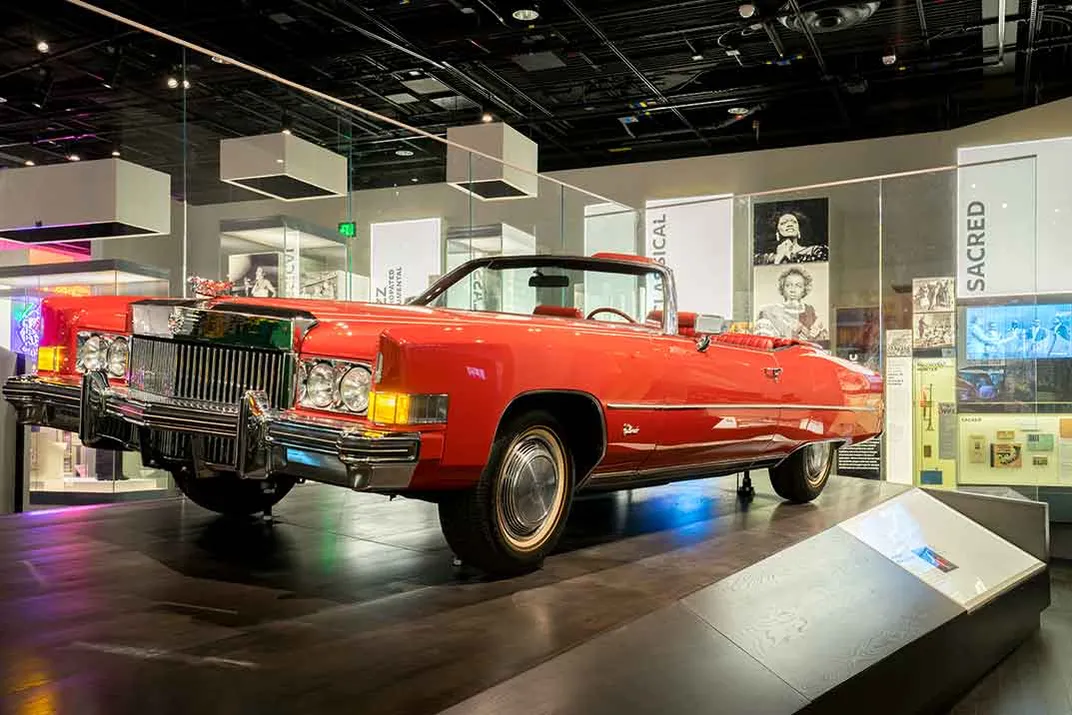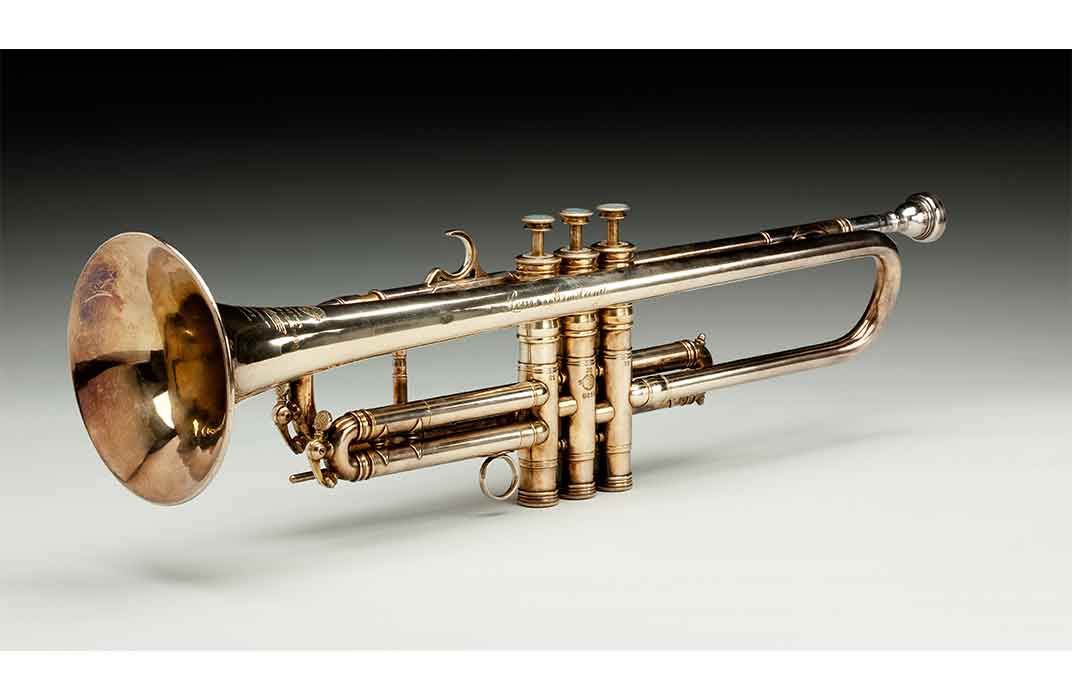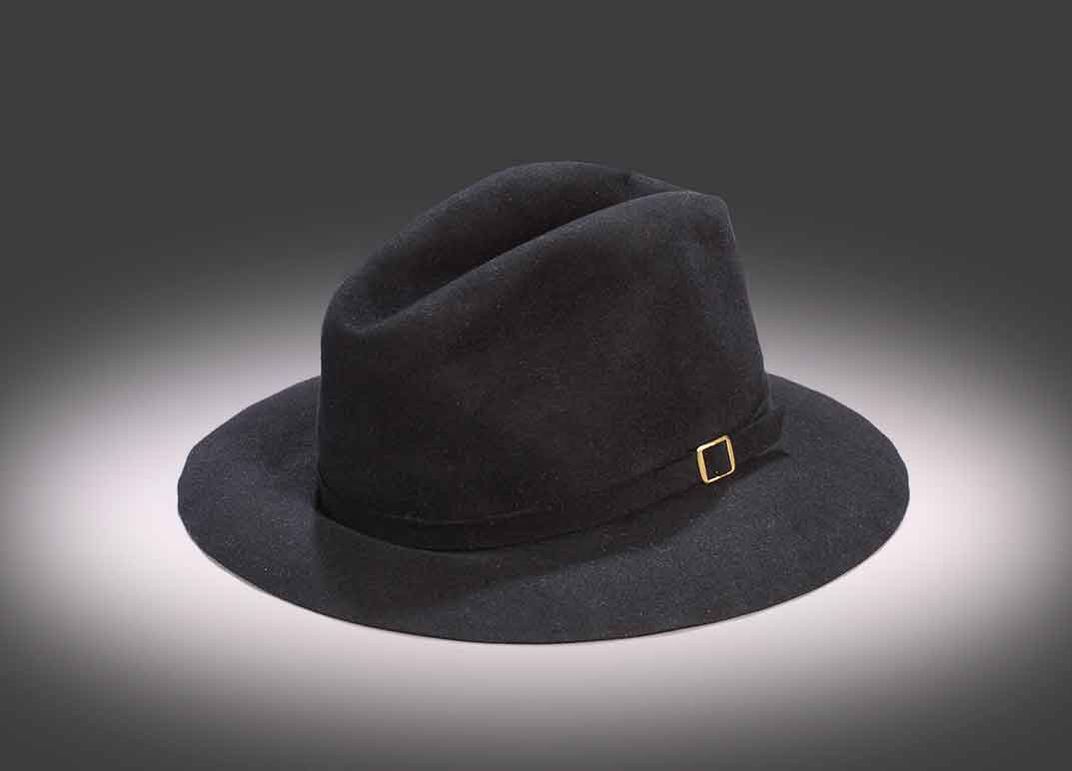The New Exhibition on Black Music Could Give Other Museums a Run for Their Money
The collections in the show “Musical Crossroads” at the African American History Museum are near encyclopedic in their scope
/https://tf-cmsv2-smithsonianmag-media.s3.amazonaws.com/filer/2b/4a/2b4a8de5-4dce-4e53-bb8a-16bab5df65ac/dsc06089web.jpg)
Music is so much a part of black America, it pops up all over the vast new National Museum of African American History and Culture. From Harriet Tubman’s modest hymnal of spirituals to Sly Stone’s signed Fender Rhodes keyboard and Public Enemy’s boom box that helps close the 20th-century cultural history, there’s no separating the importance of music from the history on hand.
But when one arrives at the entry to the fourth floor “Musical Crossroads” exhibition, heralded by the sparkly red finish on Chuck Berry’s Cadillac, the futuristic fantasy of the Parliament-Funkadelic mothership replica, and Michael Jackson’s Victory Tour fedora, it is as if entering its own inclusive African-American Music History Museum.
And inclusive it is—with displays on African music imported by the enslaved to this country, devotional music that helped bind black communities against all odds, gospel, minstrel music, ragtime, jazz, blues, rhythm & blues, rock ’n’ roll, hip-hop and EDM. Yes, and some country stars of color as well.
One of the challenges of opening the Smithsonian’s newest major museum was acquiring its contents from scratch. Sure, the nearby National Museum of American History already had a lot of artifacts, from Scott Joplin sheet music to Dizzy Gillespie’s B-flat trumpet.

But it was important not to raid other museums; those artifacts were part of the American story.
It was up to Musical Crossroads curator Dwandalyn Reece to amass the objects that would fill the 6,200 square foot space.
Other American music museums had a significant head start on major artifacts—from Cleveland’s Rock & Roll Hall of Fame to the Experience Music Project in Seattle. And that’s not to mention all of the historical items in all of the Hard Rock Cafes around the world.
In the more than 20 years since she started her career, Reece says, “the whole concept of music as memorabilia has flourished.”
Still, there was something about the prestige of the Smithsonian that convinced many to donate cherished and long-held heirlooms that were not previously seen or available.
One of the most impressive things about the museum is that relics like Little Richard’s flashy jacket or Chuck Berry’s car, were donated directly from the artists themselves. Others, like Bo Diddley’s signature square guitar and porkpie hat, were given by their estates.

Some families donated items that were not previously known to have existed at all, such as the ensemble that the celebrated opera singer Marian Anderson wore as she sang on the steps of the Lincoln Memorial in 1939. The historic concert before a crowd of more than 75,000 people and millions more on radio had been organized with the help of First Lady Eleanor Roosevelt after the Daughters of the American Revolution refused to allow Anderson to sing to an integrated audience at its Constitution Hall.
“That’s a tremendous event in the history of the United States and in music,” Reece says. Her outfit that day “would have been a wished-for item if I’d known it existed. But I didn’t know it existed.”
While researching another object however, she says, “we were put in contact with the family and they let us know that they still had the outfit and they were willing to donate it to the museum.”
Flashy as it is, the shiny red 1973 Cadillac Eldorado convertible at the Musical Crossroads entrance may not seem to have anything to do with Chuck Berry, other than simple ownership. He started pioneering Rock ’n’ Roll by mixing of country and R&B two decades earlier.

But, Reece says, “the car has its own symbolism.”
It was driven on stage for the big superstar tribute concert for Berry captured in the 1987 movie Hail! Hail! Rock ’n’ Roll.
“It’s more than just a shiny object that’s standing in the center of the museum,” she says. “It’s also a symbolic element of Chuck Berry’s own personal story and career, tied to his relationship, growing up in St. Louis, Missouri, and not being allowed to go to the Fox Theatre as a child, because of his race. And then you have this moment where he’s driving a car across the stage at this same theater 40 years later. Everything represented by that—the freedom and liberation and sense of achievement of an African-American man who is one of the architects of America’s greatest exports, Rock ’n’ Roll, and what that says about music from that standpoint. Where does music function as a tool of liberation and protest and individuality in American culture and African-American culture.”
A Chuck Berry guitar that he nicknamed “Maybellene” is also part of the display—one of more than a dozen or so guitars on display.
But there are other items tied to individual artists that helped define their place in music and the American imagination—from the wire rim glasses of Curtis Mayfield to the eyepatch of Slick Rick; from the cape (and signed shoes) of James Brown to the star-shaped guitar and outfit of Bootsy Collins. And there are the tiny tap shoes once worn by a 3-year-old Sammy Davis Jr.
One never knows what particular item will provide that instant connection to the artist it represents, but it can come in artifacts big and small—from the elaborate dresser kit of Lena Horne to the singular metal cigarette lighter of bluesman Josh White.
A 1946 Selmer trumpet played by Louis Armstrong represents that jazz great; Miles Davis’ legacy is marked by a stylish jacket he wore in the 1960s. The formidable dress of Ella Fitzgerald, and M.C. Hammer’s parachute pants are also under glass (as if to say, “Can’t Touch This”).
One ensemble does double duty—a costume from Lady Sings the Blues calls to mind the both singer who wore it, Diana Ross, and the character she portrayed, Billie Holiday, who is otherwise represented by an oversized acetate of a 1953 10-inch studio album, “An Evening with Billie Holiday.”
Along the way, there are artists represented who will likely be unfamiliar to wide audiences, from 19th century composer Francis Johnson to early prodigy Blind Tom Wiggins (whose flute is on display). Visitors will learn of both “sacred” steel guitar player Felton Williams and early ’70s Detroit punk band Death.
Some artists may seem shortchanged. Sam Cooke is represented by a contract signature; the Jackson 5 by Jermaine’s costume (with the Gary, Indiana, musician representing Detroit), Janet Jackson by a cassette of “Control.” Frankie Beverly’s cap is there, but there does not seem to be anything from Al Green.
Hundreds of albums are on display in a record store flip format, but the covers are affixed to durable materials and fastened to their crates so as to withstand the expected crush of visitors. “We didn’t want album covers all over the floor, or tossing them around,” Reece says.
One area will allow visitors to spend time to sit in a producer or engineer’s seat to create a track. Another interactive area shows the relationships of songs to regions and other genres.
When asked to divulge her favorite object, Reece can’t ignore the triangular Parliament/Funkadelic mothership. “The thing that resonates the most for me is not only that George Clinton donated it, but it was the public reaction to the acquisition,” she says. “For some reason it touched a positive nerve in people, in people seeing the Smithsonian as their place, as being interested in their history.”
Sometimes, people think of a national museum as elite and apart from regular people, Reece says. “But this resonated with people,” she says. “And I’m so proud of that.”
The inaugural exhibition Musical Crossroads is on view in the National Museum of African American History and Culture. All free timed entry passes to visit the museum have currently been distributed through the month of December. Passes for 2017 are available beginning Monday, October 3, at 9 a.m. A limited number of same-day timed entry passes are offered each day at the museum and are distributed on a first-come, first-served basis beginning at 9:15 a.m.
/https://tf-cmsv2-smithsonianmag-media.s3.amazonaws.com/accounts/headshot/RogerCatlin_thumbnail.png)
/https://tf-cmsv2-smithsonianmag-media.s3.amazonaws.com/accounts/headshot/RogerCatlin_thumbnail.png)